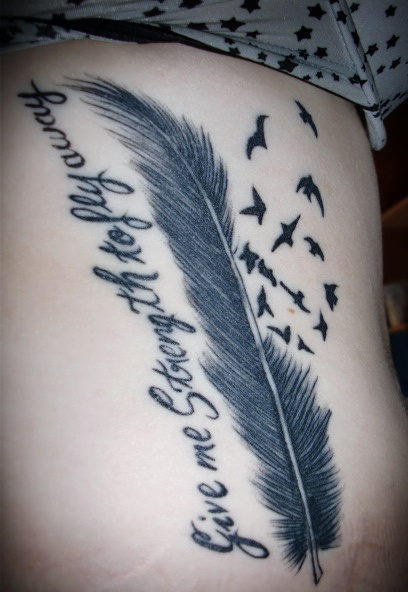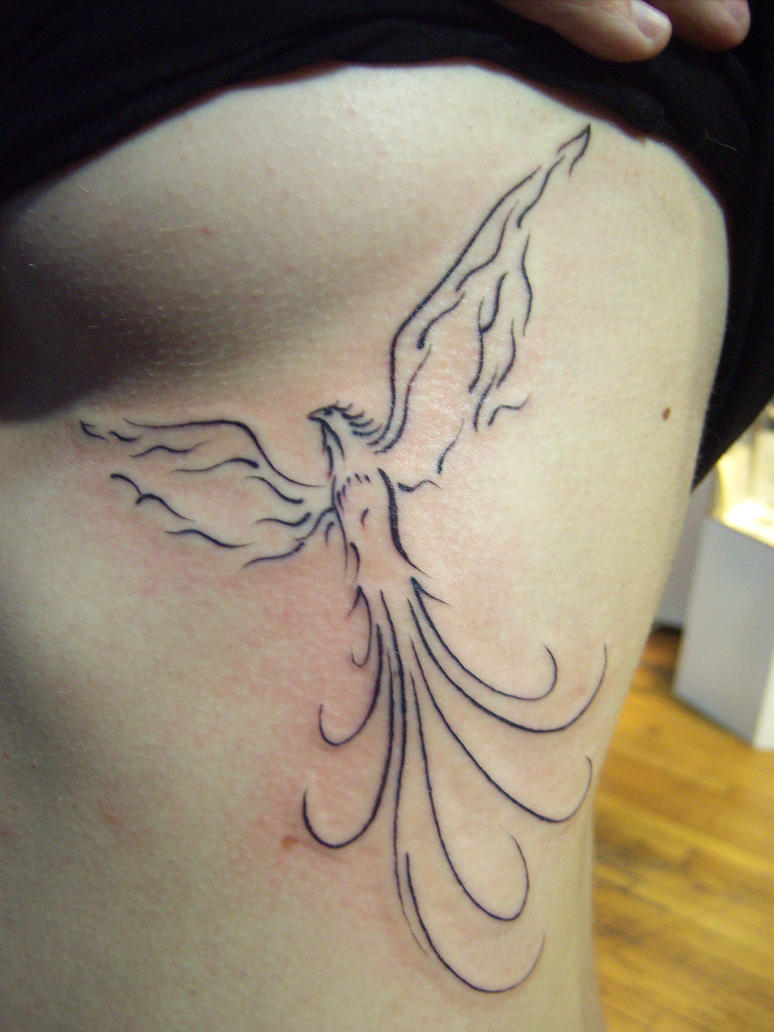Source(google.com.pk)
Side Tatoos Biography
Today it's fashionable to get as much permanent ink on your skin as possible. Is this a healthy trend?
I had never given the subject of tattoos much thought other than occasionally to regret getting mine—until my wife, Janet, and I were ministering in New Zealand in 2003. New Zealand was settled more than 1,000 years ago by a primitive Polynesian people called the Maori. They were headhunters and cannibals who worshipped demon gods. The Maori tattoo most of their bodies, including their faces, which they carve flesh from as a wood carver would etch wood to create a design. Then they apply ink.
On a day off we went sightseeing with a local pastor. He took us to a Maori village. Inside the entrance of the village was a meeting house, and above the entrance was a statue of a demon, the face of which was carved with the same pattern as the men’s faces. I immediately came to the realization that these people had carved their faces to look like the deity they worshiped.
The Lord spoke very clearly to me to study every people group, not just the Maori, and then write a book. As a result, I spent nearly two years researching the origins and history of tattoos and piercing. I studied Pacific Islanders, Native Americans, Europeans, Mid-Easterners, Asians and Africans in my
"Yes, I have tattoos. Please don't judge me before you know why I wear them."- Aaron Cannistraci Read the counter argument to this article here.
I discovered that all primitive pagan cultures throughout history and on every continent subscribed to some form of body modification or mutilation, usually involving tattoos and/or piercing. In most cases the practice was a part of demon worship. Many groups such as the Maori tattooed themselves to look like the demons to gain acceptance and power from them.
In 1991 hikers in Europe found the frozen, well-preserved body of an “Alpine Iceman.” More than 5,000 years old, he is the oldest frozen mummy ever discovered. He was found with a grass cape, a copper axe, a quiver full of arrows, flint for making fire, and numerous tattoos on his body, including a cross on the inside of the left knee. (It was not a so-called “Christian tattoo.”) He had six straight lines 15 centimeters long above the kidneys, and numerous parallel lines on the ankles.
Subsequent X-rays of his body revealed chronic degeneration of bone and cartilage in the spine and arthritic wear and tear of the knees and ankles. Presumably these tattoos were done by a shaman or medicine man who was invoking the gods on behalf of this man to rid his body of pain.
In 1891, archaeologists discovered the 4,000-year-old mummy of an Egyptian priestess of Hathor—the Egyptian goddess of love. She had parallel lines tattooed on her arms and thighs as well as an elliptical design below her navel. The tattoo below her navel is believed to have had sexual connotations linked to fertility.
Headhunters such as the Maori from the Philippines, Taiwan and other Pacific islands tattooed themselves to appease the gods before the headhunt and to commemorate their success afterward. South American headhunters also used tattoos as part of their rituals. The Hawaiians have actual tattoo gods they consult before doing a tattoo. The Chinese and Japanese used tattoos to ward off evil spirits, to appease different gods and, like the Romans, to identify or “brand” criminals. Roman slaves were tattooed as a sign of ownership, often marked, “Tax Paid.”
Native Americans tattooed themselves and their captives. The Inuit tattooed themselves upon arriving in the cold arctic regions to appease the gods so they would allow them to settle there and survive in the harsh climate.
In the Mideast, Babylonian and Canaanite and Hebrew shrine prostitutes tattooed themselves as part of their worship. Baal worshipers wore tattoos on their hands to gain power from Baal. In India, shrine prostitutes tattooed themselves to look like the various gods they worshiped. In primitive areas of India the wife of the village sorcerer is the tattoo artist.
Because of their dark skin, black Africans didn’t use tattoos as much as they used scarification. This involves cutting the skin with a sharp instrument and then rubbing it with ashes or caustic plant juices that form permanent blisters. Dark pigments, such as charcoal or gunpowder, are then rubbed into the wound to provide emphasis. The wounds are periodically reopened to enhance the raised scar effect.
Other African traditions involve extreme forms of body piercing. Lips and ears are pierced and objects implanted inside, causing the lip or ear tissue to elongate and conform to the shape of the object. Ethiopian women wear a lip plate, which causes the mouth to protrude to resemble the beak of the spoonbill, a creature they worship.
The letting of blood and body modification have always been associated with pagan worship and witchcraft. Pagans and Christians alike know there is power in the blood. In spite of the current interest in tattoos even in the church, all research points to one conclusion: The root of tattooing never changes; it is, and always has been, a pagan spiritual activity.










Side Tatoos Biography
Today it's fashionable to get as much permanent ink on your skin as possible. Is this a healthy trend?
I had never given the subject of tattoos much thought other than occasionally to regret getting mine—until my wife, Janet, and I were ministering in New Zealand in 2003. New Zealand was settled more than 1,000 years ago by a primitive Polynesian people called the Maori. They were headhunters and cannibals who worshipped demon gods. The Maori tattoo most of their bodies, including their faces, which they carve flesh from as a wood carver would etch wood to create a design. Then they apply ink.
On a day off we went sightseeing with a local pastor. He took us to a Maori village. Inside the entrance of the village was a meeting house, and above the entrance was a statue of a demon, the face of which was carved with the same pattern as the men’s faces. I immediately came to the realization that these people had carved their faces to look like the deity they worshiped.
The Lord spoke very clearly to me to study every people group, not just the Maori, and then write a book. As a result, I spent nearly two years researching the origins and history of tattoos and piercing. I studied Pacific Islanders, Native Americans, Europeans, Mid-Easterners, Asians and Africans in my
"Yes, I have tattoos. Please don't judge me before you know why I wear them."- Aaron Cannistraci Read the counter argument to this article here.
I discovered that all primitive pagan cultures throughout history and on every continent subscribed to some form of body modification or mutilation, usually involving tattoos and/or piercing. In most cases the practice was a part of demon worship. Many groups such as the Maori tattooed themselves to look like the demons to gain acceptance and power from them.
In 1991 hikers in Europe found the frozen, well-preserved body of an “Alpine Iceman.” More than 5,000 years old, he is the oldest frozen mummy ever discovered. He was found with a grass cape, a copper axe, a quiver full of arrows, flint for making fire, and numerous tattoos on his body, including a cross on the inside of the left knee. (It was not a so-called “Christian tattoo.”) He had six straight lines 15 centimeters long above the kidneys, and numerous parallel lines on the ankles.
Subsequent X-rays of his body revealed chronic degeneration of bone and cartilage in the spine and arthritic wear and tear of the knees and ankles. Presumably these tattoos were done by a shaman or medicine man who was invoking the gods on behalf of this man to rid his body of pain.
In 1891, archaeologists discovered the 4,000-year-old mummy of an Egyptian priestess of Hathor—the Egyptian goddess of love. She had parallel lines tattooed on her arms and thighs as well as an elliptical design below her navel. The tattoo below her navel is believed to have had sexual connotations linked to fertility.
Headhunters such as the Maori from the Philippines, Taiwan and other Pacific islands tattooed themselves to appease the gods before the headhunt and to commemorate their success afterward. South American headhunters also used tattoos as part of their rituals. The Hawaiians have actual tattoo gods they consult before doing a tattoo. The Chinese and Japanese used tattoos to ward off evil spirits, to appease different gods and, like the Romans, to identify or “brand” criminals. Roman slaves were tattooed as a sign of ownership, often marked, “Tax Paid.”
Native Americans tattooed themselves and their captives. The Inuit tattooed themselves upon arriving in the cold arctic regions to appease the gods so they would allow them to settle there and survive in the harsh climate.
In the Mideast, Babylonian and Canaanite and Hebrew shrine prostitutes tattooed themselves as part of their worship. Baal worshipers wore tattoos on their hands to gain power from Baal. In India, shrine prostitutes tattooed themselves to look like the various gods they worshiped. In primitive areas of India the wife of the village sorcerer is the tattoo artist.
Because of their dark skin, black Africans didn’t use tattoos as much as they used scarification. This involves cutting the skin with a sharp instrument and then rubbing it with ashes or caustic plant juices that form permanent blisters. Dark pigments, such as charcoal or gunpowder, are then rubbed into the wound to provide emphasis. The wounds are periodically reopened to enhance the raised scar effect.
Other African traditions involve extreme forms of body piercing. Lips and ears are pierced and objects implanted inside, causing the lip or ear tissue to elongate and conform to the shape of the object. Ethiopian women wear a lip plate, which causes the mouth to protrude to resemble the beak of the spoonbill, a creature they worship.
The letting of blood and body modification have always been associated with pagan worship and witchcraft. Pagans and Christians alike know there is power in the blood. In spite of the current interest in tattoos even in the church, all research points to one conclusion: The root of tattooing never changes; it is, and always has been, a pagan spiritual activity.
Side Tatoos Designs Photos Pics Wallpapers 2013

Side Tatoos Designs Photos Pics Wallpapers 2013

Side Tatoos Designs Photos Pics Wallpapers 2013

Side Tatoos Designs Photos Pics Wallpapers 2013

Side Tatoos Designs Photos Pics Wallpapers 2013

Side Tatoos Designs Photos Pics Wallpapers 2013

Side Tatoos Designs Photos Pics Wallpapers 2013

Side Tatoos Designs Photos Pics Wallpapers 2013

Side Tatoos Designs Photos Pics Wallpapers 2013

Side Tatoos Designs Photos Pics Wallpapers 2013

Side Tatoos Designs Photos Pics Wallpapers 2013
No comments:
Post a Comment